Report from Vienna of 2017, the Austrian Minister of Culture made a long-awaited and much approved announcement, the appointment of Martin Kušej as the new director of Austria’s most important venue, the Burgtheater in Vienna. Kušej has come close to this position twice before. He was considered for post in 2009 but Matthias Hartmann was selected instead. When Hartmann left in 2014, under a cloud of financial scandal, the position was offered to Kušej , but he was under contract at the Munich Residenztheater until 2016 and was unwilling to leave. Now he will assume directorship of the Burg in 2019.
In the meantime, Kušej produced a new work for the Burg, Arthur Miller’s The Crucible (Hexenjagd) which opened at the end of 2016 and which I saw in Vienna during a visit in January, 2018. It is a powerful retelling of Miller’s story, which Kušej , like most recent directors of the piece, sees as a political parable, not only of the McCarthy era in America, but of the continuing political dynamic of repression and distortion as a means of power and control.

Martin Kušej’s The Crucible (Hexenjagd). Photo: Reinhard Werner.
Kušej wrote his Master’s thesis on Robert Wilson, and there is often a touch of Wilson monumentality and minimalism in Kušej settings, usually the creation of his scenic collaborator, Martin Zehetgruber. This is certainly the case here, where Zehetgruber has created a set composed entirely of a forest of monumental, but simple crosses on the Berg’s huge revolving stage, which, with varying lighting, can become a forest, a prison, and with lighting mostly from below, the massive beams that support the courtroom. In its simplicity and flexibility, the setting is one of the most memorable features of the production. Only in the prison scene did the concept weaken, when a number of large cages were scattered among the upright beams, but essentially never used. Their single use, indeed, I found unnecessary and distracting. The scene opens with a Kušej addition—the black slave Tituba (Barbara Petrisch) is raped in one of the cages by a prison guard, after which both somehow manage to leave the cage and the scene so that the main action can continue. After this the cages serve merely as a not very effective background.
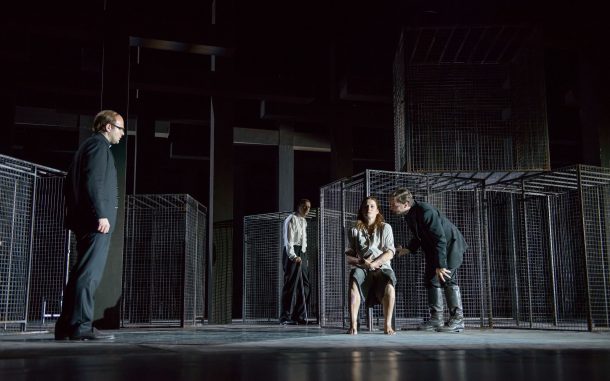
Martin Kušej’s The Crucible (Hexenjagd). Photo: Reinhard Werner.
The production is presented in a slow, deliberate, and on the whole rather internalized style, which accords well with the repressed society presented, but loses dramatic tension from time to time in the over three-hour, very deliberate production. Steven Scharf as John Proctor is quite overshadowed by Dörte Lyssewski in her role of his embittered and suffering wife. The wavering Mary Warren is very effectively portrayed by Marie-Luise Stockinger, especially in her central court-room examination. The villains, as is often the case, are rather more theatrically interesting than the heroes—the corrupt Reverend Parris (Philipp Hauß), the harded, chain-smoking Reverend Hale (Florian Teichtmeister), and especially the sadistic governer-deputy Danforth (Michael Maertens), who injects a much needed relief note of grotesque humor into the courtroom scene.
The choric presence of the young women, spread out among the columns upstage in the courtroom scene and elsewhere, was always powerful, and especially so in the erotic scenes that Kušej has added. Most strikingly, the production opens with a frenzied orgy of the young women in the forest of crosses, removing their clothing and indulging in an ecstatic scene of strangulation and masturbation. This overt display of the play’s repressed sexuality breaks out again in the erotic and violent night scene between Abagail (Andrea Wenzl) and Proctor and into the courtroom where, under the pressure of her companions and the supercharged situation, Mary Warren slowly performs a strip-tease during her testimony.
I was struck during my week in Vienna, as I have been before in my German-language theatre-going, how much more common the image of the naked body is in German-language theatre culture than in the Anglo-Saxon. All three of the productions I saw in Vienna utilized this, and although one can see how the repressed sexuality of The Crucible might suggest the use of nudity, its appearance in a play like Ibsen’s Enemy of the People was quite a surprise. But more of that later.
All three productions, even more typical of the contemporary theatre, were deeply involved with current political questions. No such question has more resonance in today’s Europe than that of immigration, and the next production I saw dealt directly with this concern, in a highly controversial and unconventional manner. I saw Homohalal by the Syrian-Kurdish playwright Ibrahim Amir, now a resident of Vienna, three nights after its opening on January 17 and was fortunate to be able to get a ticket to the mostly sold-out production. Two years ago the play was scheduled to be performed at a major Vienna house, the Volkstheater, but its darkly comedic dystopian exploration of the immigration crisis was considered by the theatre directors too inflammatory, and it never opened.

Ibrahim Amir’s Homohalal. Photo: Yasmira Haddad.
In March of 2017 the play was at last premiered in the Staatsschauspiel of Dresden, a city that has been a center of anti-immigrant protest, where it enjoyed a considerable success, paving the way for its premiere in Vienna, not at a major house, but at one of the capital’s leading experimental theatres, Werk X, which specializes in productions dealing with areas of current cultural, religious, and economic conflict. The piece is set in Vienna in the year 2037, when Austria, somewhat surprisingly, has been declared the most leftist liberal country in the world. Here citizens of all cultures live peacefully and harmoniously together, but the funeral of a former immigrant brings together a group of fellow immigrants and others connected with them, who were all gathered at the occupation of the Votive Church in Vienna almost a quarter of a century earlier.
The funeral is that of Abdul, who was a victim of the final conflict in 2018 between liberal and reactionary forces, and who was betrayed to the police by his comrades, who have survived and prospered under the new order. They now live in a comfortable, well-to-do environment, nicely if minimally represented by a large brightly colored swimming pool which takes up a good deal of the stage (designer Renato Uz). Although the urn presumably containing Abdul’s ashes is introduced early in the play, and suffers a good bit of farcical knocking about until it inevitably ends (as do most of the actors from time to time) in the waters of the pool, Abdul is in fact alive. He returns to confront his prosperous former friends and repeats the action which led to his original arrest: his attempt to set fire to a group of fascist police on whom he had thrown gasoline. He now repeats this action against his terrified former companions, until after a tense and extended dousing of everyone with gasoline, he is shot by one of the women as he lights a match and he ends up, of course, floating in the pool.
Before that catastrophe, we see the considerable psychic cost to the various characters for their present comfort and the aggression, jealousies, unresolved tensions, and antagonisms that still lie not far beneath the surface. The most powerful of these grow from the challenges of integration and the difficulties, if not impossibilities, of overcoming long-standing prejudice. Thus, the Iraqi refugee Said, after a three year relationship with Barbara, a Christian supporter of immigrant rights seeks to marry her. She, fearing that the threat of deportation matters more to him than love of her, refuses, and so he is sent unwillingly back to Iraq, where he marries unhappily and has a homosexual son, whom he rejects and despises. Not all the stories are this tragic, but none of the characters feel that the political stability for which they struggled has brought any of them satisfaction for the past wrongs suffered. All of this sounds grim indeed, but the piece is written and performed not as a tragedy, but as a dark farce, complete with slapstick turns, pratfalls, and the constant threat of falling, with huge splashes, into the dominant pool. Director Ali M. Abdullah and his talented cast nicely remain on the knife-edge between the serious and the absurd, which provides a startlingly fresh perspective on this often-treated topic, and one which, not surprisingly, has disturbed the settled views of many.
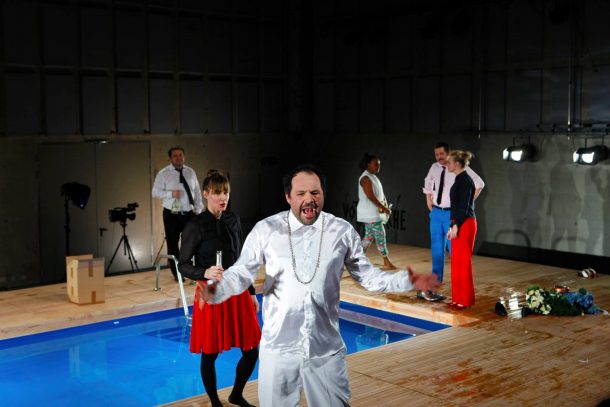
Ibrahim Amir’s Homohalal. Photo: Yasmira Haddad.
Each of the Vienna productions I saw offered me fresh experiences and insights, but the third, of a long-familiar play, Ibsen’s Enemy of the People, provided the most surprises and left me with the most striking visual memories. The director, Jette Steckel, is clearly one of the rising stars of the German theatre. Hers is a theatre family, her mother being stage designer Susanne Raschig and her father Frank-Patrick Steckel, one of the leading German directors of the late twentieth century. She graduated from the Hamburg Theater Academy in 2007 and that same year was named young director of the year by Theater heute for her direction of a new work, Nightblind by Darja Stocker. Since then she has directed a wide range of European classics at the Berlin Deutsches Theater and the Hamburg Thalia, where she has been resident director since 2013/14. This is her second production at the Burgtheater; she presented there a highly unconventional but very successful Antigone in 2015, which is still a popular offering in the theatre’s repertoire.
Steckel’s production was characterized as “deconstructive” in several reviews, a popular term in German for the work of directors that take radical liberties with both the texts and traditional interpretations of staging conventions of familiar works, especially those of Shakespeare, Ibsen, Chekhov, and the German and Greek classic authors. The text Steckel uses, created by her father, follows the general outlines of Ibsen’s plot, but with much cutting (including the character of Captain Horster) and updating of lines. Steckel has carried this process further, incorporating many specific references to recent and current political events in Austria and elsewhere, and radically changing the ending of the play.
Toward the end of the last century, with a rising public consciousness of ecological threats, Ibsen’s play was often presented as a cautionary tale about pollution. While this concern has certainly not lessened either in society or in interpretations of the play, more recent productions have often paid more attention to Stockmann’s discovery announced in the famous fourth act—that the polluted springs are symbolic of an even deeper problem, that society itself is polluted, by the myth of democracy as an ideal form of government. Both of these concerns are clearly present in Steckel’s interpretation, and are intricately interwoven. Perhaps not surprisingly, she has long been an active member of Greenpeace, and some negative reviews of the production condemned it not as deconstruction but as agitprop.
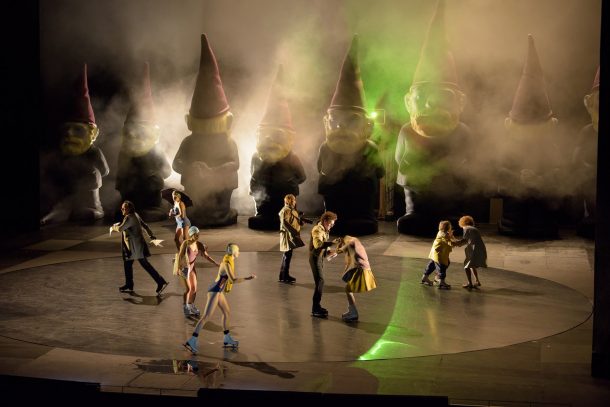
Jette Steckel’s Enemy of the People. Photo: Georg Soulek.
When the curtain rises, we are already far from the conventional world of Ibsen production. The stage is a huge black void, containing only a drifting cloud of smoke or steam—not a hint of walls or furnishings. Suddenly, downstage, in the traditional location of the prompter’s box, a handsome, nude male body erupts from an unseen pool of water. This is Joachim Meyerhoff, a leading and much-honored member of the Burgtheater ensemble, who plays Thomas Stockmann. He goes far upstage center, where a thin column of water begins pouring from a showerhead far up in the theatre flies. After a few moments in the shower, Meyerhoff goes to a small red metal suitcase, suddenly spotlighted on the stage, and takes from it towels and his costume, the main element of which is a large and bulky orange anorak, which he will wear for most of the production. The red suitcase also will regularly appear in the rest of the production, one of the few physical properties on this minimalist stage. The scenic designer is Steckel’s usual partner, Florian Lösche, perhaps best known for the enormous net which was the sole setting for Steckel’s production of Woyzeck in Hamburg in 2010.
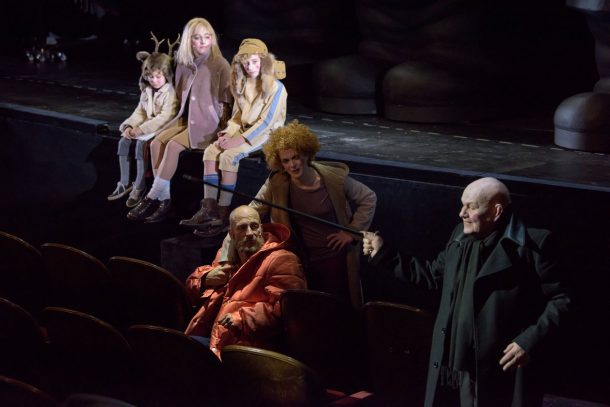
Jette Steckel’s Enemy of the People. Photo: Georg Soulek.
When the clothed Meyerhoff carries the suitcase offstage we are left with the opening image of black void and cloud, but now an image is projected onto the cloud and filtered through it to appear, in shimmering form, on the dark back wall. It is the title of the play, in German EIN VOLKSFEIND with a modern barcode above it. This image converts the sequence we have just seen into something common in contemporary film and TV, but quite rare in the theatre, a “cold open,””pre-credit” or “teaser” giving the audience a powerful opening image before the title of the work appears. This and the bar code immediately plunge us into the world of contemporary capitalist society, which clearly forms the ground for all that follows.
The action begins with Stockmann’s dinner guests standing in the same black void—no table, no furniture, no walls or props. Only when Stockmann’s brother, the mayor arrives does a kind of scenic background appear, but it is far from a conventional frame. His entrance is a remarkable one. Usually the dyspeptic Peter is not an especially attractive physical specimen, but Mirco Kreibich, in a slim, form-fitting elegant powder blue suit, cuts a dashing figure next to his brother, whose attractive frame is usually lost in his enveloping anorak. Moreover, Peter does not walk in, but glides in, and we realize for the first time that the stage floor is covered with ice and that he is on skates. As the evening progresses, those who support the mayor perform more gracefully on this tricky surface, while Thomas, lacking skates, moves ploddingly and sometimes unsurely. When we lift our eyes from the gliding Peter, we become aware of a set of huge dark shapes that have come in behind the mayor. These form the most striking physical image of the production, eight identical troll-like traditional garden gnomes, each about 8-9 feet high, with pointed red hats, blue suits, flowing yellow beards, healthy rounded white faces, blue eyes, blank expressions, and hands behind their backs. From this point on they are a continuing part of the stage picture, gliding singly or in groups around the stage (apparently moved by technicians inside each figure), or gathering like an ominous chorus upstage. In the one scene where they are not present, that in the newspaper office, there is for the first time a hint of a box set, with vertical strips of white material forming a kind of back wall perhaps ten feet wide between two black wings. All during the scene the distinctive shadows of three of the figures can be seen projected against this wall and thus they are always psychically present. The printer Aslaksen (Peter Knaack), the “man of the people,” whom these figures apparently represent, can also be seen in silhouette, assiduously polishing the noses or smoothing the hair of these passive figures.
In fact only those familiar with the play will remember that this scene takes place in the editorial office. In this production, there is a single item of furnishing, an elegant grand piano at which an elegantly dressed musician (Martin Mader) sits, accompanying the entire scene with soft harmonies. The high point of the scene (and arguably of the play) occurs when the Mayor glides in as usual, between the rear white hangings, and as he delivers his own version of the current situation to the dazzled Billing (Matthias Mosbach) and Hovstad (Ole Lagerpusch), he presents an increasingly elaborate skating performance as he speaks, with astonishing turns and pirouettes, followed by the faithful musician. This bravura performance draws extended and well-deserved applause from the audience.
The Town Hall meeting, the turning point of the play, is reduced to its simplest elements, Stockmann and his audience—the trolls. Ibsen’s preliminary negotiations are gone. The scene begins when Stockmann climbs on his faithful red suitcase downstage left and begins to address the group of trolls, facing him upstage right. As his oration continues and he receives no response from them, he becomes increasingly agitated, moving across the stage to confront them more directly, shouting, and even employing a bullhorn. He even checks the chest of one with the stethoscope he wears around his neck throughout the evening, but all is in vain. The figures continue to stand impassively or even to turn casually away from him. At last as he moves directly up to them, they begin to gradually push back. Stockman finds himself surrounded and slowly forced backward downstage until at last an inexorable wall of expressionless figures literally forces him to jump from the stage into the orchestra, in front of the first row of seats.
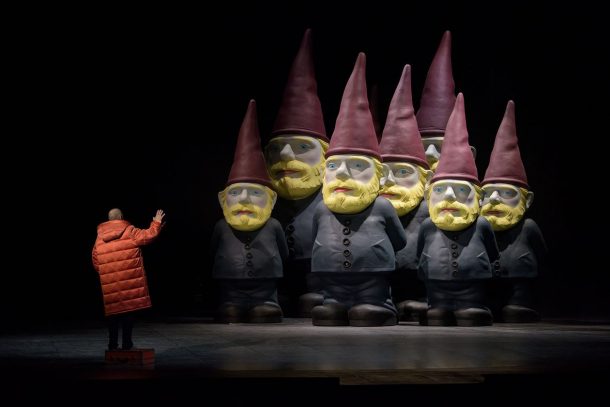
Jette Steckel’s Enemy of the People. Photo: Georg Soulek.
Stockmann moves along the front row until he comes to an empty seat, which he apparently rips up from the floor and turns with it back to the stage. Here he sits, and as his family gathers around him and the trolls gaze out impassively from the stage, he delivers a lengthy and scathing address to the audience. The opening up of the fourth act to the actual theatre audience has been seen several times in recent German productions of Ibsen’s play, most famously in Thomas Ostermeier’s 2012 production at the Berlin Schaubühne, which toured internationally. The dynamic here is totally different however. Ostermeier’s Stockmann stopped the show and challenged the audience to discuss tensions in their current society. Although this experiment was accepted by some audience and rejected by others, its primary aim was to stimulate engaged dialogue. Steckel’s apparent aim was quite different, however. It was a direct attack on the audience as representatives of the “liberal majority” who allowed themselves to be manipulated by corrupt leaders and the media. Although some of Ibsen’s condemnation of this majority remained, it became much more specific and confrontational. Austria’s recent growing support for former neo-fascist Christian Strache, just named Vice-Chancellor, and for similar far-right politicians now and traditionally, were cited, and the audience was characterized as “a roomful of apathetic ass-lickers.” Indeed the Burgtheater audience has traditionally been characterized as comfortably conservative, if not outright reactionary politically, and this has resulted in another long tradition of major Burtheater directors and authors portraying this audience as covert fascists. This in turn has led to a long tradition of bitter theatre riots at the Burg over such depictions, most famously during the preparations and performances of Thomas Bernhard’s Heldenplatz in 1988, to which Steckel’s Stockmann specifically refers.
Somewhat disappointingly, no riots have greeted the Steckel production, although there were a respectable number of boos and audience members loudly departing the night I attended, but I had rather the feeling that this sort of confrontation had almost become part of the Burgtheater experience. Official displeasure was much more evident in the many negative reviews of the production, almost all of which considered what Steckel had done to Ibsen to be essentially crude agitprop. A few expressed surprise that talented actors would allow themselves to be so used. Not being a part of the Austrian political dynamic and not being too disturbed by radical reworkings of classic texts, so long as these seem to me artistically or intellectually interesting, I found the production, on the whole quite fascinating. Toward the end of the last century, when environmental and pollution concerns achieved new prominence, that aspect of Ibsen’s play was usually foregrounded. In the new century, many directors began to focus upon Stockmann’s discovery during the play, revealed in the fourth act, that the problem is not the baths but the belief that right lies with the majority opinion, and I have seen a number of more recent productions that stress that aspect. Steckel’s, aside from the power of its visual images, is also the most successful I have seen, not only in stressing both issues, but also in demonstrating how closely they are tied together.
I also felt that this production, after breaking out of the world of the play in the fourth act, moved on to a more satisfactory and consistent conclusion than did that of Ostermeier, whose final act, though closer to Ibsen, I found distinctly anticlimactic. When Stockmann has finished his denunciation, a figure pushes through the trolls. It is Stockmann’s father-in-law, the cunning capitalist Morten Kiil, beautifully played by Ignaz Kirchner, a pillar of the Burgtheatre. As in Ibsen, he has used Mrs. Stockmann’s inheritance to buy up shares in the baths, now almost worthless due to Stockmann’s revelations, and he showers these on the appalled family. Unlike in Ibsen, Kiil here appears as a kind of deus ex machina, announcing that he will use his remaining funds to refurbish the baths and convince the media and the public that they are truly an attractive operation. We do not here see the results of this, at least not the direct results, but we see something far more powerful. The scene abruptly ends after Kiil’s announcement and suddenly a film appears projected on the act drop and showing a surfer riding within a giant wave which slowly engulfs him. Several minutes of much more disturbing visual images follow—the Japanese tsunami, devastating hurricanes, floods, and oceans awash in oil spills, huge blocks of glaciers falling into roiling seas. Accompanying this devastating visual montage is the song “No Surprises,” by the English alternative rock band Radiohead. The lyrics of the song, describing the pursuit of happiness by a public unable or unwilling to see how they are being manipulated by external powers, is chillingly appropriate on its own, but much more so is the memory of the music video released with the recording showing only the head of lead singer Thom Yorke within a kind of space or diver’s helmet, singing the lyrics as the helmet gradually fills with water, eventually completely covering his face. From Stockmann’s opening burst from the hidden pool to this concluding image of death by drowning, the production achieved an unusually powerful and coherent marshalling of images.
Marvin Carlson, Sidney E. Cohn Professor of Theatre at the City University of New York Graduate Center, is the author of many articles on theatrical theory and European theatre history, and dramatic literature. He is the 1994 recipient of the George Jean Nathan Award for dramatic criticism and the 1999 recipient of the American Society for Theatre Research Distinguished Scholar Award. His book The Haunted Stage: The Theatre as Memory Machine, which came out from University of Michigan Press in 2001, received the Callaway Prize. In 2005 he received an honorary doctorate from the University of Athens. His most recent book is a theatrical autobiography, 10,000 Nights, University of Michigan, 2017.
European Stages, vol. 11, no. 1 (Spring 2018)
Editorial Board:
Marvin Carlson, Senior Editor, Founder
Krystyna Illakowicz, Co-Editor
Dominika Laster, Co-Editor
Kalina Stefanova, Co-Editor
Editorial Staff:
Taylor Culbert, Managing Editor
Nick Benacerraf, Assistant Managing Editor
Advisory Board:
Joshua Abrams
Christopher Balme
Maria Delgado
Allen Kuharsky
Bryce Lease
Jennifer Parker-Starbuck
Magda Romańska
Laurence Senelick
Daniele Vianello
Phyllis Zatlin
Table of Contents:
- Berlin Theatre, Fall 2017 by Beate Hein Bennett
- 2018 Berliner Theatertreffen by Steve Earnest
- Speaking Out by Joanna Ostrowska & Juliusz Tyszka
- Political Theatre Season 2016-2017 in Poland by Marianna Lis
- Hymn to Love in a Love-less World: Chorus of Women, Berlin 2017 by Krystyna Lipińska Illakowicz
- Wyspiański: From Wagner, Through Brecht, to Artaud? The Curse and The Wedding in Poland Today by Lauren Dubowski
- A Theatrical and Real Encounter with Zabel Yesayan: A Play by BGST by Eylem Ejder
- Report from Vienna by Marvin Carlson
- Motus and Me: In Appreciation of the Italian Theatre Group Motus by Tom Walker
- Actors without Directors: Setkání/Encounter Festival of Theatre Schools in Brno, Czech Republic, 17-21 April 2018 by Matti Linnavuori
- Ghosts, Demons and Journeys: Barcelona Theatre 2018 by Maria M. Delgado
- Two Samples of Documentary Theatre in Hungary by Gabriella Schuller
- Two East European Festivals by Steve Wilmer
- The Misted Stage: Eirik Stubø’s Stagings of Tragedy by Eylem Ejder
- Amadeus in London by Marvin Carlson
- Two Significant Losses
www.EuropeanStages.org
europeanstages@gc.cuny.edu
Martin E. Segal Theatre Center:
Frank Hentschker, Executive Director
Marvin Carlson, Director of Publications
©2018 by Martin E. Segal Theatre Center
The Graduate Center CUNY Graduate Center
365 Fifth Avenue
New York NY 10016



